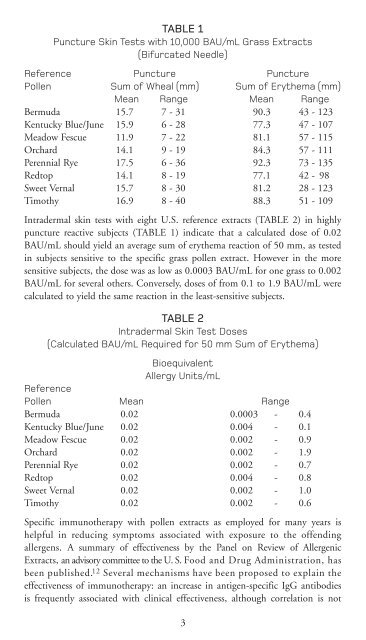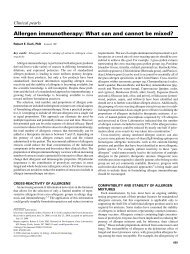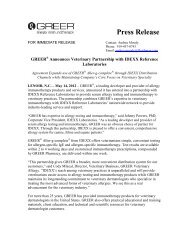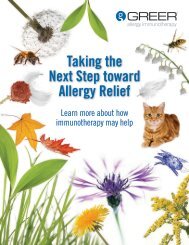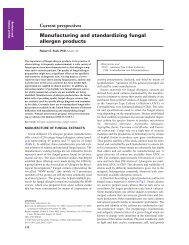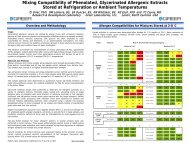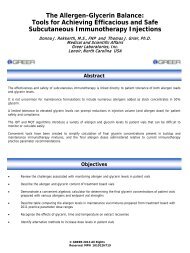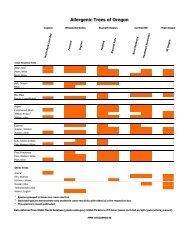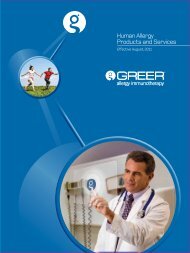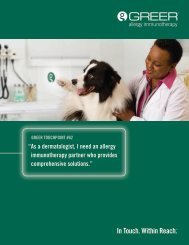TABLE 1Puncture Skin Tests with 10,000 BAU/mL Grass Extracts(Bifurcated Needle)Reference Puncture PuncturePollen Sum of Wheal (mm) Sum of Erythema (mm)Mean Range Mean RangeBermuda 15.7 7 - 31 90.3 43 - 123Kentucky Blue/June 15.9 6 - 28 77.3 47 - 107Meadow Fescue 11.9 7 - 22 81.1 57 - 115Orchard 14.1 9 - 19 84.3 57 - 111Perennial Rye 17.5 6 - 36 92.3 73 - 135Redtop 14.1 8 - 19 77.1 42 - 98Sweet Vernal 15.7 8 - 30 81.2 28 - 123Timothy 16.9 8 - 40 88.3 51 - 109Intradermal skin tests with eight U.S. reference extracts (TABLE 2) in highlypuncture reactive subjects (TABLE 1) indicate that a calculated dose of 0.02BAU/mL should yield an average sum of erythema reaction of 50 mm, as testedin subjects sensitive to the specific grass pollen extract. However in the moresensitive subjects, the dose was as low as 0.0003 BAU/mL for one grass to 0.002BAU/mL for several others. Conversely, doses of from 0.1 to 1.9 BAU/mL werecalculated to yield the same reaction in the least-sensitive subjects.TABLE 2Intradermal Skin Test Doses(Calculated BAU/mL Required for 50 mm Sum of Erythema)Bioequivalent<strong>Allergy</strong> Units/mLReferencePollen Mean RangeBermuda 0.02 0.0003 - 0.4Kentucky Blue/June 0.02 0.004 - 0.1Meadow Fescue 0.02 0.002 - 0.9Orchard 0.02 0.002 - 1.9Perennial Rye 0.02 0.002 - 0.7Redtop 0.02 0.004 - 0.8Sweet Vernal 0.02 0.002 - 1.0Timothy 0.02 0.002 - 0.6Specific immunotherapy with pollen extracts as employed for many years ishelpful in reducing symptoms associated with exposure to the offendingallergens. A summary of effectiveness by the Panel on Review of AllergenicExtracts, an advisory committee to the U. S. Food and Drug Administration, hasbeen published. 12 Several mechanisms have been proposed to explain theeffectiveness of immunotherapy: an increase in antigen-specific IgG antibodiesis frequently associated with clinical effectiveness, although correlation is not3
consistent in all studies; there is a decrease in specific IgE; and IgE production issuppressed during periods of seasonal or high exposure to the antigen. 13 Otherchanges following immunotherapy have been noted including development ofauto-anti-idiotypic antibodies, a decrease in blood basophil sensitivity to allergen,a decrease in lymphokine production and lymphocyte proliferation by cellsexposed to allergen, and development of allergen-specific suppressor cells. 14 Thecomplete mechanisms of immunotherapy are not known and remain the subjectof investigation.Standardized versus nonstandardized extracts: Standardized grass pollen extractscannot be directly compared to the previously marketed nonstandardized extractconcentrates of the same grass pollens such as those labeled at 1:10 w/v or 1:20w/v or at 20,000 to 40,000 PNU. The potency of the nonstandardized extractsvary from species to species. Some nonstandardized grass pollen concentrateshave been from a few thousand BAU/mL to several hundred thousand BAU/mLas measured by in vitro ELISA testing. Extracts of some lots of <strong>Greer</strong> nonstandardizedglycerinated 1:20 w/v extracts such as Meadow Fescue and Redtop havetested over 200,000 BAU/mL. Two Timothy aqueous nonstandardized 1:10 w/vaqueous extract lots were over 200,000 BAU/mL. Several lots of nonstandardizedconcentrates of Kentucky Blue/June, Orchard, Perennial Rye, and Sweet Vernalvaried around 100,000 BAU/mL. Bermuda grass is not as potent. The FDABermuda reference is assigned 10,000 BAU/mL, a value similar to that foundin several <strong>Greer</strong> lots of nonstandardized Bermuda. This is the maximum availablestrength of standardized Bermuda grass pollen extract. See TABLE 3 for examplesof BAU potency by in vitro ELISA testing for nonstandardized grass pollenextracts.TABLE 3BAU/mL of Previously Marketed, Nonstandardized,Grass Pollen Extracts BAU/mL Range by In Vitro ELISA*Pollen # of 1:10 w/v Aqueous # ofLots Lots 1:20 w/vTested Tested glycerinatedBermuda 1 10,740 5 4,000 to14,500Meadow Fescue 3 287,300 to 666,000 4 169,200 to 378,200Kentucky Blue/June 3 56,100 to 145,400 4 56,100 to 91,500Orchard 2 134,000 to 139,200 5 71,200 to 110,500Redtop 3 141,900 to 425,000 4 134,600 to 219,200Perennial Rye 4 59,100 to 302,000 4 52,900 to 80,400Sweet Vernal 2 171,900 to 234,800 5 63,900 to 201,200Timothy 3 186,300 to 291,000 3 63,000 to 104,800Extracts testing between 67,300 and 148,600 are not statistically different from100,000 BAU/mL. Extracts which test between 6,730 to 14,860 are notstatistically different from 10,000 BAU/mL.4


